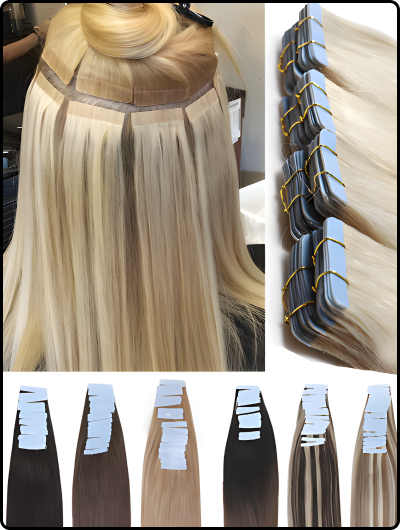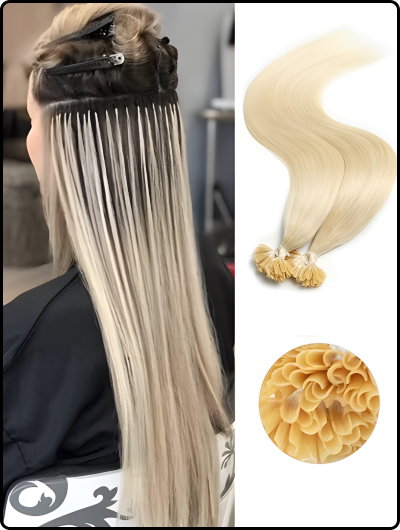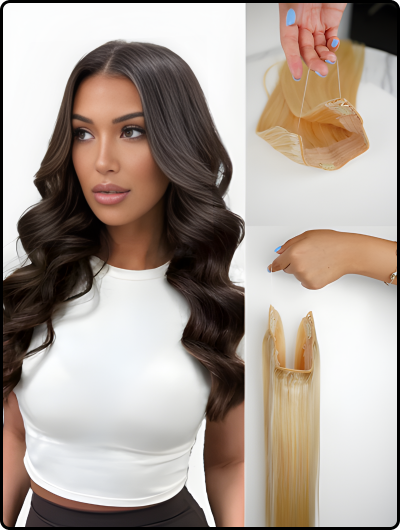Have you ever looked at someone’s gorgeous, voluminous hair and wondered how they do it? For many, the secret lies in hair extensions. These clever additions have become a beauty essential for those who want to add instant length, thickness, or even a pop of colour without commitment. If you’re in London, a visit to a professional Hair Extension Salon London can make all the difference in achieving a flawless, natural look. But with so many types of hair extensions available, choosing the right one for your hair and lifestyle can be a bit overwhelming. Whether you’re new to the world of extensions or thinking about switching up your current style, this ultimate guide will walk you through everything you need to know about the different types of hair extensions, how they work, and which might be the best match for you.
Understanding Hair Extensions
Before diving into the various types of hair extensions, it’s important to understand what they actually are. Hair extensions are strands of real or synthetic hair. That are attached to your natural hair to create a fuller or longer appearance. They can be applied in several ways, from temporary clip-ins to more permanent methods like tape-ins, micro-rings, and keratin bonds.
Extensions can also vary by hair type. You’ll often hear about Remy hair, which is high-quality human hair that keeps the cuticle intact, meaning it looks natural, feels soft, and lasts longer.On the other hand, synthetic hair is made from man-made fibres and can be a budget-friendly option. However, it doesn’t always blend as seamlessly with natural hair or allow for heat styling.
Once you understand these basics, it’s easier to navigate through the different options and choose the one that suits your needs, budget, and lifestyle best.
Clip-In Hair Extensions

Clip-in hair extensions are a fantastic choice for beginners or anyone who loves a quick transformation. They consist of wefts of hair attached to small clips that easily snap onto your natural hair. One of the biggest advantages of clip-ins is how simple they are to use. You can apply them in minutes and remove them just as easily at the end of the day.
These are ideal if you’re after a temporary change, such as adding volume for a night out, a wedding, or a photoshoot. Because you can take them out daily, clip-ins don’t put stress on your natural hair, making them one of the least damaging options. They also allow you to experiment with different looks and colours without commitment.
However, clip-in extensions do require some maintenance. You’ll need to wash and style them occasionally to keep them looking fresh. Make sure to store them properly to prevent tangling. For best results, go for clip-ins made from Remy human hair, as they blend beautifully with natural hair and can be styled with heat tools.

Tape-In Hair Extensions

Next on the list are tape-in hair extensions, one of the most popular professional methods available today. These extensions come with a pre-taped strip that attaches to your natural hair using a heat tool or special adhesive. The process is relatively quick, usually taking about an hour at a salon, and the results are natural, and long-lasting.
Tape-ins are perfect for those looking for a semi-permanent solution. They lie flat against the scalp, making them comfortable and discreet, even when your hair is up. With proper care, they can last between six to eight weeks before needing reapplication.
The key to maintaining tape-in extensions is looking after both your natural hair and the adhesive bonds. Use sulphate-free shampoo and avoid applying conditioner directly on the roots to keep the tapes from slipping. Regular salon maintenance is essential to reposition them as your hair grows.
Tape-in extensions are an excellent balance between convenience and longevity. They’re ideal if you want a low-maintenance option that still delivers a natural, polished finish.

Micro-Ring Hair Extensions

Micro ring hair extensions or micro-bead hair extensions are another popular choice for those who prefer a heat-free method. With this technique, small sections of your natural hair are threaded through tiny metal rings. Individual strands of extension hair are then clamped in place.
The benefit of micro-rings is that they don’t require glue or heat. This makes them a gentler option for your natural hair. They’re also reusable, so with proper care, you can reapply the same extensions multiple times. This method gives a very natural look and allows your hair to move freely without any stiff bonds.
However, micro-ring extensions do require regular maintenance. As your natural hair grows, the rings move away from the scalp and need to be repositioned every few months. If not maintained properly, the beads can cause tangling or tension at the roots.
They’re perfect for those who want a longer-term solution that’s still flexible and relatively kind to the hair. Just make sure to visit a qualified stylist who’s experienced in this method to ensure the best results.

Fusion or Pre-Bonded Hair Extensions

Fusion hair extensions, also known as pre-bonded or keratin bond extensions, are one of the most durable and long-lasting types of hair extensions. Each strand of extension hair comes with a keratin bond at the tip, which is fused to your natural hair using a special heat tool.
This method can take several hours to apply. However, the results are incredibly natural and can last for up to six months with proper care. Because each strand is attached individually, the hair falls and moves just like your own.
Fusion extensions are great for those who want a seamless, long-term solution that requires minimal daily effort. However, the application involves heat. It’s important to have it done by a professional to avoid damage to your natural hair. Regular maintenance and gentle hair care are key to keeping them looking their best.
You’ll need to avoid using oils or heavy conditioners near the bonds, as they can weaken the keratin. And when it’s time for removal, always visit a salon—trying to remove them yourself can lead to breakage.

Sew-In or Weave Hair Extensions

Sew-in hair extensions, commonly known as weaves, involve braiding your natural hair into cornrows and sewing wefts of extension hair onto the braids with a needle and thread. This method is often chosen by those with thick or coarse hair, as it provides excellent hold and durability.
Sew-ins are long-lasting and can handle everyday styling, including heat tools. They’re also a great protective style, as your natural hair is tucked away and shielded from daily wear and tear. Depending on your hair growth and maintenance routine, sew-ins can last six to ten weeks before needing to be redone.
The key to healthy sew-ins is ensuring that your scalp remains clean and moisturised. Because your natural hair is covered, it’s easy for the scalp to become dry or itchy. Regular scalp massages and a light leave-in conditioner can help keep everything healthy underneath.
Sew-ins do take longer to apply and remove, but the results are worth it if you’re after a full, natural look with plenty of volume.

Halo Hair Extensions

Halo Hair Extensions have gained huge popularity in recent years, and it’s easy to see why. Unlike most other types of hair extensions, halos don’t require any clips, tapes, or beads. Instead, they come with an invisible wire that sits comfortably around the crown of your head, allowing the extensions to blend naturally with your hair.
They’re one of the easiest and safest options available, especially for beginners or those who want zero damage. You can pop them on in seconds, style them as you wish, and take them off before bed. They add instant length and thickness while keeping your natural hair completely untouched.
Halo extensions are also perfect for those who want a temporary option without the hassle of salon appointments. Whether you’re going to a special event or just want to boost your everyday look, they’re a fuss-free solution that delivers beautiful, natural-looking results.

Choosing the Right Type of Hair Extensions for You
With so many different types of hair extensions to choose from, how do you decide which one is best for you? The answer depends on a few key factors: your lifestyle, hair type, budget, and how long you want the extensions to last.
If you’re someone who loves changing your look often, clip-ins or halo extensions are ideal. They’re quick to use, easy to remove, and allow you to experiment without any long-term commitment.
For a semi-permanent solution, tape-ins offer a natural finish with relatively low maintenance, while micro-rings are perfect if you prefer a heat-free application.
If you’re after a long-lasting, salon-quality transformation, fusion or sew-in extensions might be the right choice. They take more time to apply but deliver stunning, natural results that can last for months.
It’s also important to consider your natural hair’s condition. Fine or fragile hair may not handle heavier extension types like sew-ins, so lightweight options like tape-ins or halos are usually better suited. On the other hand, those with thicker or textured hair can enjoy the durability and fullness of sew-ins or micro-rings.
Always consult a professional stylist before making your final decision. They can assess your hair’s health and recommend the best method and type of hair to achieve your desired look safely.
Caring for Your Hair Extensions

No matter which type of hair extensions you choose, proper care is crucial for keeping them looking beautiful and extending their lifespan. Always use gentle, sulphate-free hair products and avoid applying conditioner near the roots or bonds. Brush your hair gently with a wide-tooth comb or a special extension brush to prevent tangles.
Heat styling should be done carefully, using a heat protectant spray. Try to limit how often you use straighteners or curling irons, especially with synthetic extensions. When washing your hair, avoid scrubbing too vigorously and always pat dry instead of rubbing.
At night, it’s best to loosely braid your hair or tie it into a low ponytail to prevent tangling while you sleep. And remember, regular salon visits are essential for maintaining semi-permanent extensions like tape-ins, micro-rings, and fusion bonds.

Achieve Your Dream Hair with Extensions
Hair extensions have truly revolutionised the world of beauty, offering endless ways to express yourself and enhance your natural look. From quick and easy clip-ins to long-lasting keratin bonds, there’s a method to suit everyone. The key is understanding the different types of hair extensions and choosing the one that best fits your lifestyle and hair goals.
Whether you’re dreaming of mermaid-length locks, fuller volume, or just a touch of added glamour, extensions can make it happen. With the right type, professional guidance, and a bit of care, you’ll be turning heads and loving your look every day.
So if you’ve been considering a hair transformation, why wait? Explore the different types of hair extensions available and discover just how easy it is to achieve the hair you’ve always wanted.
FAQ
What are the most popular types of hair extensions?
The most popular types include clip-in extensions, tape-ins, micro-ring (or micro-bead) extensions, fusion (keratin bond) extensions, sew-ins (weaves), and halo extensions. Each type offers different levels of permanence, styling options, and maintenance requirements.
How long do hair extensions last?
The lifespan of hair extensions depends on the type and care. Clip-ins and halo extensions are temporary and can last a few months with proper care. Tape-ins and micro-rings typically last six to eight weeks before reapplication, while fusion or sew-in extensions can last up to six months with regular maintenance.
Can hair extensions damage natural hair?
Extensions are generally safe when applied correctly. Heat-free methods like tape-ins, halos, and micro-rings are gentler, while fusion and sew-ins require professional application to avoid stress or breakage. Proper care and regular maintenance are essential to prevent damage.
How do I choose the right type of hair extensions?
Consider your lifestyle, hair type, budget, and how long you want the extensions to last. Temporary options like clip-ins and halos suit those who want flexibility, while semi-permanent or long-term options like tape-ins, micro-rings, and fusion extensions are better for lasting results.
Can I style hair extensions with heat tools?
Most human hair extensions can be styled with heat tools, but synthetic hair should be treated carefully or not heated at all. Always use a heat protectant spray and avoid applying direct heat to the bonds, clips, or tapes.
How should I care for my hair extensions?
Use gentle, sulphate-free shampoos, brush extensions carefully with a wide-tooth comb or extension brush, and avoid sleeping with them loose to prevent tangling. For semi-permanent extensions, regular salon maintenance is key to keeping them looking natural and healthy.

